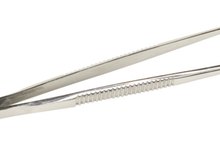What does fact checked mean?
At Healthfully, we strive to deliver objective content that is accurate and up-to-date. Our team periodically reviews articles in order to ensure content quality. The sources cited below consist of evidence from peer-reviewed journals, prominent medical organizations, academic associations, and government data.
The information contained on this site is for informational purposes only, and should not be used as a substitute for the advice of a professional health care provider. Please check with the appropriate physician regarding health questions and concerns. Although we strive to deliver accurate and up-to-date information, no guarantee to that effect is made.
How To Remove a Dead Tick
According to the Centers for Disease Control and Prevention (or, simply, the CDC), ticks are vectors for pathogens such as Lyme disease or Rocky Mountain fever in humans, both of which can have serious consequences. Therefore, it's important to remove a tick, whether it's dead or alive, as quickly as possible.
If you are experiencing serious medical symptoms, seek emergency treatment immediately.
Because the tweezers might touch an open wound, sanitize them using rubbing alcohol.
How to Get an Embedded Tick Out
Learn More
Using the tweezers, pinch the skin on either side of the tick, then pull the tweezers away. It's possible that the tick is not yet dead, and if this is the case, it will detach itself once enough pressure is applied to the area around the skin, according to Lymesite, a Lyme disease support site 2.
If the tick is dead or it doesn't detach, pinch it with the tweezers by pressing them as close to the point of attachment on the skin as possible, grasping the tick near the embedded mouth parts. Be careful not to crush the body or head, as this may force more toxins into the bloodstream.
How to Tell If I Did Not Remove the Whole Tick
Learn More
Pull outward with steady force. Do not twist the tweezers, as this also may force more fluids into the skin or result in more mouth parts being left behind.
Clean your hands with soap and water so that you do not infect the wound.
Clean the wound with soap and water. The CDC says not to be alarmed if mouth parts are left behind, as Lyme disease cannot be transmitted this way.
Disinfect the tweezers using the alcohol.
Place the dead tick in a clean, labeled glass jar if you fear that it may have carried Lyme disease. Label the jar, including the date you noticed the tick and the location where you believe you acquired the tick.
Send the tick to a lab for disease testing. Some private labs specialize in this, and public-health labs perform testing (see Resources).
Warnings
If the tick is alive, do not kill it by smothering it in petroleum jelly, alcohol or burning it. This will likely agitate the tick and cause it to inject infectious agents into the bloodstream.
Related Articles
References
- CDC: Tick removal
- Lymesite: Removing a tick
- Centers for Disease Control and Prevention (CDC). Lyme Disease. CDC.gov.
- Centers for Disease Control and Prevention (CDC) staff. Tick Borne Diseases of the United States. CDC.gov.
- Centers for Disease Control and Prevention (CDC) staff. Overview of Tickborne Diseases. CDC.gov.
- Johns Hopkins Medicine, Rheumatology staff. What to do After a Tick Bite. Johns Hopkinsrheumatology.org.
- Mayo Clinic staff. Patient Care and Health Info. Tick Bites: First Aid. Mayo Clinic.org.
- Ostfeld, R. (2018) 8 Facts About the Ecology of Lyme. The Cary Institute of Ecosystem Studies. Caryinstitute.org.
- Zecken de Das Infoportal. About Ticks. Zecken.de.
Warnings
- If the tick is alive, do not kill it by smothering it in petroleum jelly, alcohol or burning it. This will likely agitate the tick and cause it to inject infectious agents into the bloodstream.
Writer Bio
Ray Dallas graduated with majors in journalism and English. While in Florida, he wrote freelance articles for "The Alligator" and was the copy editor and a writer for "Orange & Blue." Since moving to California, Dallas has worked as a script reader and for a talent manager, as well as taking numerous industry odd jobs.





